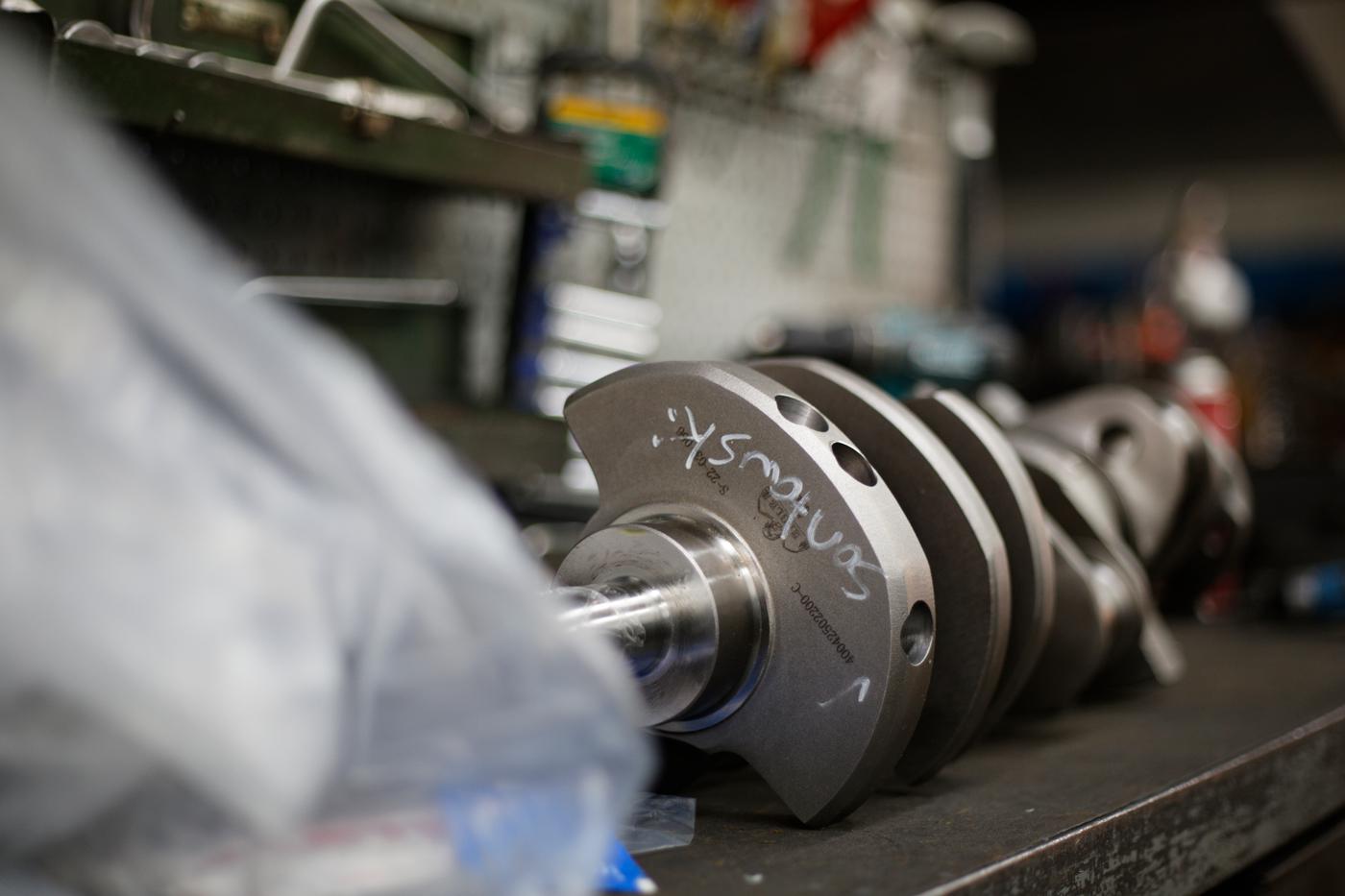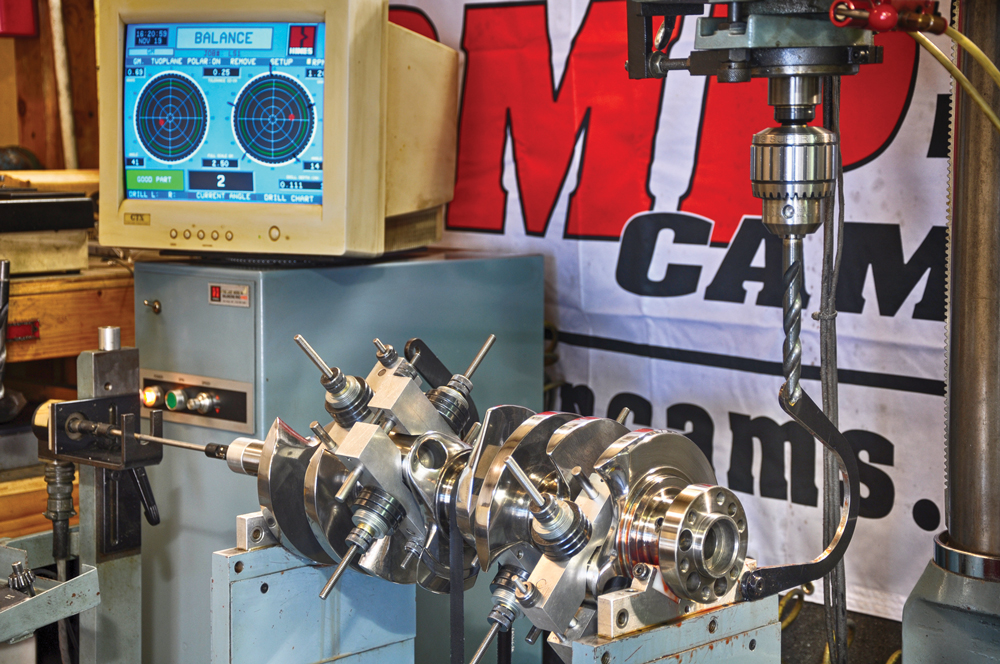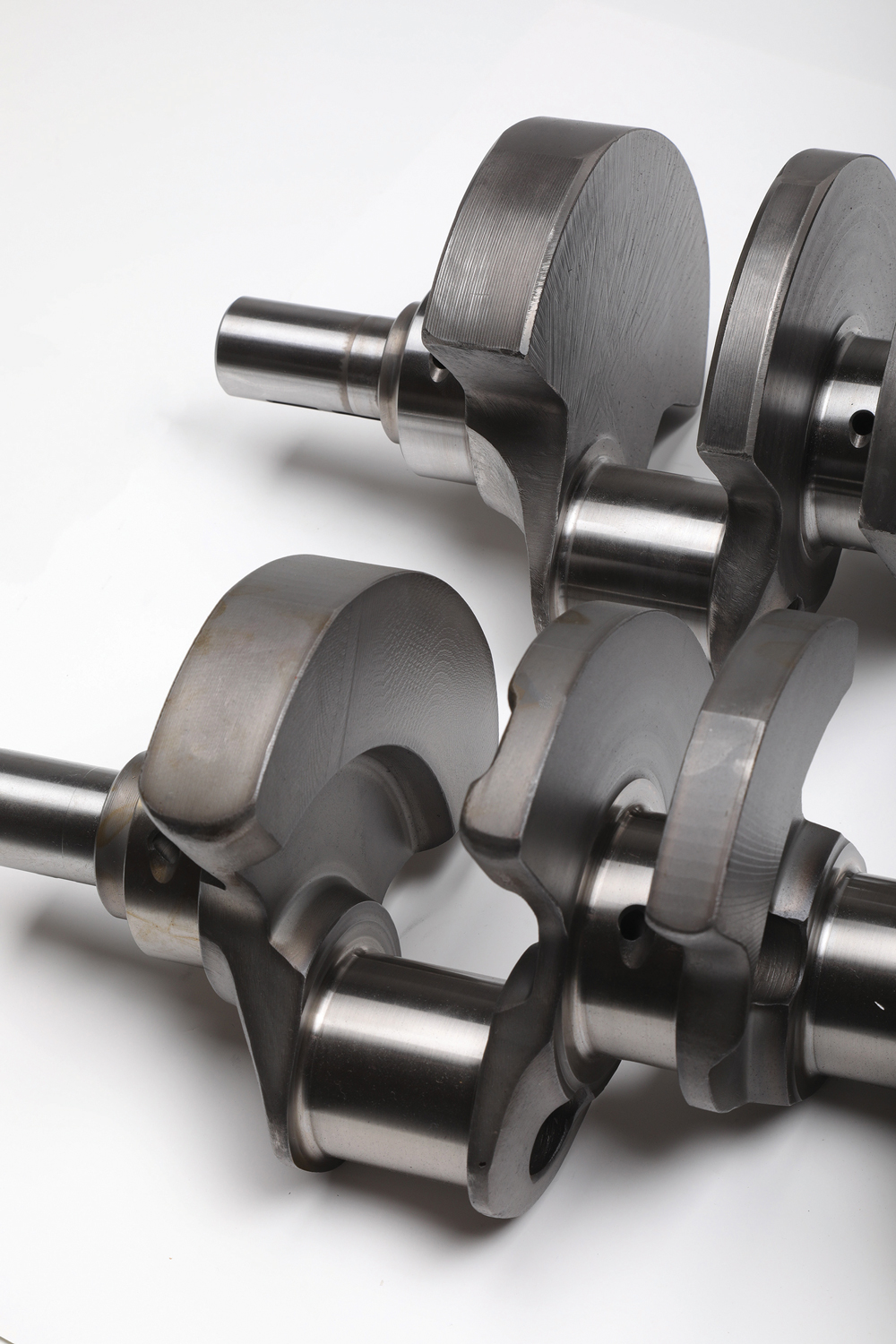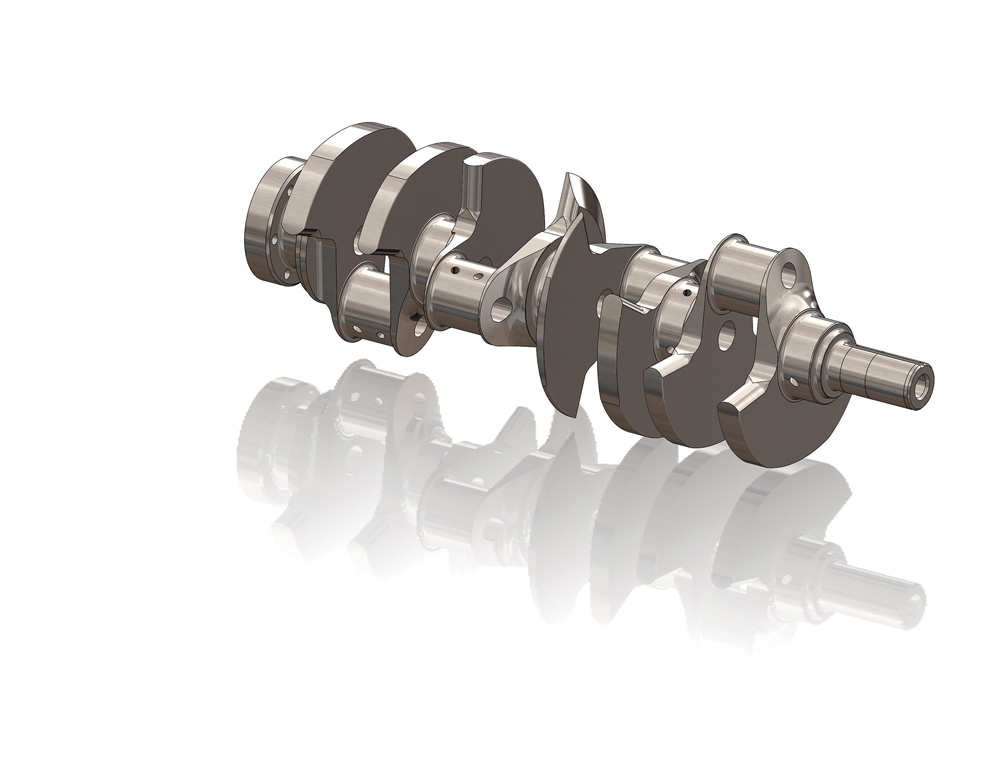Beyond The Heartbeat

Need to rev up your knowledge of racing crankshafts? Check out these tips, tricks, and advice from experts at the leading manufacturers and service shops.
In a poetic sense, a race engine’s rhythmic pulse is generated by the crankshaft and its accompanying rotating components. Seemingly simple in form but rather complex in function, the crankshaft can be a fractious topic among bench-racing circles. There are constant debates over material, construction, weight, balance, and more. Durability is always a goal, but so is freeing up horsepower. So, who has the answers?
The technical reps at crankshaft manufacturers and those companies that service crankshafts have heard all the questions and are happy to share their answers. They have stripped away the myths, analyzed the choices, and consulted with engineers to answer even the most academic and complicated questions posed by engine builders as well as weekend warriors.
The following is a sampling of some of the most-asked questions in addition to some of the more interesting queries directed at aftermarket crankshaft suppliers. There should be a revelation or two for even the most experienced racer who wants to know more about the engine’s mechanical heartbeat.

Q: The most-asked question we usually get is, “What is the horsepower rating?”
A: Really, there is no such thing as a horsepower rating. The only time horsepower comes into play is if the crank breaks in the rear area, which sees the most torque. Most other times it’s the lack of power that hurts a crankshaft; i.e. detonation is the number-one reason crankshafts get damaged. Next would be damage because of balancing issues, and lastly clearance mistakes.
—Kirk Peters, Howards Cams, Oshkosh, Wisconsin
Q: Why do some crankshafts have center counterweights?
A: Howards added center counterweights to strengthen our Billet Reaper line. By adding the center counterweights, we can reduce flex caused by torque and make the crankshaft easier to balance. When dealing with lightweight crankshafts, it’s very important to use lightweight components to maximize the advantage of gaining higher and quicker rpm.
—Kirk Peters, Howards Cams
Q: What are the advantages and disadvantages of lightweight cranks?
A: A lighter crankshaft spins up quicker and lets you get back into your powerband quicker, which is great for circle-track applications. However, this advantage is also a disadvantage in other applications. Since momentum is a function of mass, this means that while you can spin up quicker, you will also lose rpm much faster, as well. For street builds and drag-strip applications, going too light on the crankshaft can be detrimental.
—Thomas Sheets, Scat Crankshafts, Redondo Beach, California
Q: Should I always choose a longer stroke?
A: While the adage “There is no replacement for displacement” is true, sometimes too much stroke isn’t ideal for a build. A longer stroke certainly gives you more torque and more power, but if your heads don’t have enough air flowing into the engine, that extra power is going to waste. If you’re using power adders, you may not need a longer stroke, as the extra air generated by the power adders provides the boost in power. Finally, if you’re going to have a high-revving engine, a longer stroke inhibits how fast you can spin the crank.
—Thomas Sheets, Scat Crankshafts
Q: Is a forged crank always better than a cast crank?
A: It is true that a forged crank will always be stronger than a cast steel crank. However, due to the grain structure present in a forging, sometimes it is overkill for a particular build. While the ratings vary based off the engine platform, cast cranks tend to be a couple of pounds lighter than forged cranks due to the density of forged steel. Basically, there is more meat per square inch in a forging. So, for street builds that are naturally aspirated, sometimes a cast crank may be the better choice.
—Thomas Sheets, Scat Crankshafts
Q: I’ve got a journal with a crack in it. Can it be repaired?
A: Sight unseen, it’s hard to tell, but we have been able to repair a lot of journals with fractures in them. We basically grind out the crack, weld in fresh metal, refinish the journal, and heat-treat the crank. You should see some of the really ugly stuff we’ve been able to repair!
—Dave Olsen, Mile High Crankshafts, Denver, Colorado
A: In quite a few cases, a crack in a journal fillet or oil hole can be repaired. Diameter figures into how deep we will go, but we will carefully remove material where the crack resides and make a judgment call with the engine builder once it is taken care of.
—Nick Boes, Shaftech, Findlay, Ohio
Q: What are the challenges of repairing a crack in a journal?
A: If a fracture is long enough, chances are it’s running pretty deep into the journal. But while trying to eliminate it, I can get to a point where I just don’t feel like we’ve got enough base material left in the crank for strength. If a crack is more than .250- to .375-inch deep from the journal surface, I don’t really feel like that can be a good repair for racing applications.
—Dave Olsen, Mile High Crankshafts
Q: How can you tell if a crack in a crankshaft is really trouble?
A: I recently worked on some old Ford Cosworth Indy cranks. They were museum pieces, so we weren’t really concerned about the strength of the crank. I don’t know if you’re aware that a crank has a ring to it, kind of like a tuning fork when you tap it with a small hammer up and down. And if a crank has a bad enough crack, it will actually kill the ring. These particular Cosworth cranks sounded just like a brick. And I was really amazed when I finished repairing them that they rang beautifully again.
—Dave Olsen, Mile High Crankshafts
Q: Can you reshape a counterweight?
A: You can, but I don’t do that type of work just because once a manufacturer has made a crank and it’s gone through the heat-treating, it really gets hard to machine some of the surfaces without just destroying your lathe bits. We’ll reduce the diameter of a crank, or if they want a little bit of a taper cut on one face of the counterweights, we can do that.
—Dave Olsen, Mile High Crankshafts
A: This can be done, but we don’t get into that here. Between the abuse on tooling due to the counterweights already being nitrided and the further work then trying to re-balance the crankshaft, it’s not something we have tried. Shaping counterweights will help with windage, but unless the whole assembly is getting lighter, it will make balancing the crankshaft a pretty expensive endeavor.
—Nick Boes, Shaftech

Q: How much stroke can you add?
A: This question does cause some confusion from time to time. When offset grinding, it’s a 1:1 ratio. That is, for every .001 you remove from the diameter, you can move the stroke that same amount. Realistically we need to have a little bit of stock left over to make sure the journal rounds up at the end. But generally, we figure if we are grinding .100 off a crank, we can move the stroke .095 inch up or down. The one area that may cause problems is how much material they have between the bearing diameter and the inside of the lightening hole that is usually drilled through the crankpin. If reducing stroke, this area may get too thin. Oil hole placement will sometimes cause a problem as well, depending on the amount somebody wants to add. Occasionally on special projects we will weld on half of a journal diameter in order to make large changes and still maintain the factory journal size. These can range from .250 up to 1.000 inch.
—Nick Boes, Shaftech
Q: Can you do extra-deep nitriding?
A: You can, but it generally comes with drawbacks, such as an increased compound zone (white layer), journal distortion, and softening of the core material. Many of your higher-end cranks use a thin nitride layer to provide a nice bearing surface, while the core material provides the strength and stiffness needed. This is why we re-nitride just about everything we grind here. By the time you remove .010-inch of material, the surface hardness has gone from high 50s HRC down to the high 40s. In most performance applications this will make quite a difference in how the crank performs over the remainder of its life.
—Nick Boes, Shaftech
A: We don’t have such an option. There are different nitriding processes. Ion nitriding is only a few thousandths deep, but it’s not like it goes in a few thousandths and stops. It’s hard on the surface and sort of fades away. That’s true with just about any kind of nitriding. The other kinds of nitriding, like ammonia gas, can go deeper, but you run the risk of getting what’s called the dreaded white layer, and that’s where cracks can start. While it is more expensive, ion nitride is simply a better process.
—Tom Molnar, Molnar Technologies, Kentwood, Michigan
Q: How small of a main journal can you go?
A: Good question. You are mostly limited by the path the oil holes take and what bearings are available. It is common for us to grind .150- to .200-inch off main bearings to fit one type of crank into another block.
—Nick Boes, Shaftech
Q: How do you balance weight and strength?
A: It does come down to the lightest, strongest crank you can get. The best thing going for a crankshaft is smaller outside diameter. If you have a smaller outside diameter, there’s less leverage working on the bearings, so your mains look much better. The design is generated by the stroke and bob weight, but there are limiting factors. With a bigger stroke, obviously you can’t cut the counterweights down too far, unless you put in a bunch of heavy metal.
—Peter Harris, Crower Cams & Equipment, San Diego, California
Q: Is there a particular engine that is tougher to design crankshafts for?
A: Four-cylinders are probably harder on cranks because of the up-down-down-up configuration. They tend to vibrate if you get the crankshaft too light, so they’re one of the hardest to get both lightweight and strong for the turbo guys.
—Peter Harris, Crower Cams & Equipment

Q: Is there a difference between billet and a forging?
A: We only make crankshafts out of 4340 steel here at Crower, so the forgings and the billets are the same material. We heat-treat them the same way, so they should be the same strength. The beauty of a billet is you can make it any shape you want, and you can increase overlap areas and really make a billet stronger just because you start with a blank canvas. With a forging, we’ve got certain guidelines and X amount of material.
—Peter Harris, Crower Cams & Equipment
Q: How do eight counterweights reduce crankshaft bending?
A: First, you could put a crank in a lathe, position a dial indicator in the middle of it, push on the crank with your thumb, and you can bend it slightly. That’s true with all cranks. With any crank you have weight from the rods, piston, wrist pin, etc. pulling on each rod pin. The higher the rpm, the higher those forces are. These forces are in the thousands of pounds and turn the crank into a piece of spaghetti. You need a counterweight opposite of those forces to reduce the bending. The key is getting the counterweights placed correctly to reduce that bending. If they’re not placed correctly, you will see edge loading with the bearings and destroyed mains.
—Tom Molnar, Molnar Technologies
Q: Why is journal overlap so important?
A: An example of this: A number of years ago a customer asked me to make a LS crank with eight counterweights. He said he had a 4.500-inch stroke with 1.88-inch Honda rod journals, and he wanted eight counterweights because he kept taking out the mains and thought that would fix it. A crank with LS-size mains, 4.500-inch stroke, and Honda-size rod journals does not have any overlap keeping it together, and at high rpm, the forces bend the crank. There is simply nothing to keep it straight, and it destroys the main bearings. The larger the mains, larger the rod journals, the shorter the stroke, the stiffer the crank will be.
—Tom Molnar, Molnar Technologies
Q: Please help me understand crankshaft balancing.
A: By far, the most common question we get regarding crankshafts has to do with balancing. People often misunderstand “internally balanced” as meaning the crank is already balanced out of the box. A crankshaft is not balanced by itself. A crankshaft is balanced to match the pistons and rods that are used with it. Since different rods and different pistons are different weights, it is impossible to make a crankshaft that out of the box is balanced to work with every rod and piston combination. All crankshafts must be balanced to your specific rod and piston combination.
When an Eagle crankshaft is listed as “internal balance” or “external balance,” this is stating how this crank is intended to be balanced, not if the crank is balanced or not. A crank that is balanced internally uses a damper and flywheel that do not affect the balance of the crank. They have no weights on them and therefore do not contribute to the balancing of the crank. They are “neutral” or “internal.” A crank that is externally balanced uses either a damper and/or flywheel with weights on them that contribute to the balancing of the crank. These components must be installed on the crank when the balancing is done. Some cranks are designed for a combination balance, meaning it will be internal in the front and external in the rear. A common example of this are one-piece rear-seal GM small and big block engines.

It is important to pay attention to how the crankshaft manufacturer intends its crank to be balanced. It may not be the same as OEM. A crank can be balanced otherwise, but it is much more difficult to do so. Eagle crankshafts are listed with a “target bobweight.” This is an approximation (+/-2%) of the bobweight the crankshaft is roughly “out of the box.” This is not intended to imply that the crank is balanced. It is simply provided so that the machine shop can more accurately predict what will be involved in balancing the crank so they can estimate balancing costs more accurately. Eagle crankshafts are designed to have a target bobweight higher than most typical rod and piston combinations. Therefore, in most cases, you will only need to remove material to balance the crankshaft instead of adding material, which can be expensive.
—Alan Davis, Eagle Specialty Products, Southaven, Mississippi
SOURCES
Crower Cams & Equipment
crower.com
Eagle Specialty Products
eaglerod.com
Howards Cams
howardscams.com
Mile High Crankshafts
milehighcranks.com
Molnar Technologies
molnartechnologies.com
Scat Enterprises
scatcrankshafts.com
Shaftech
shaftech.com
 MEMBERSHIP LOGIN
MEMBERSHIP LOGIN JOIN PRI
JOIN PRI


